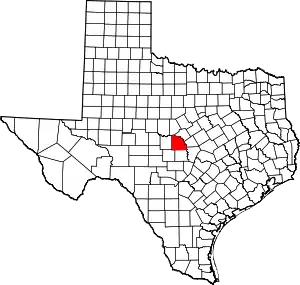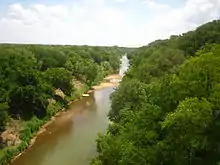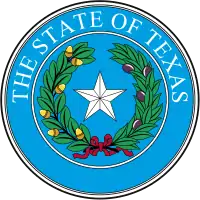San Saba County, Texas
San Saba County is a county located on the Edwards Plateau in western Central Texas. As of the 2010 census, its population was 6,131.[1] Its county seat is San Saba.[2] The county is named after the San Saba River, which flows through the county.
San Saba County | |
|---|---|
 The San Saba County Courthouse in San Saba with emblem "From the People to the People." | |
 Location within the U.S. state of Texas | |
 Texas's location within the U.S. | |
| Coordinates: 31°10′N 98°49′W | |
| Country | |
| State | |
| Founded | 1856 |
| Named for | San Saba River |
| Seat | San Saba |
| Largest town | San Saba |
| Area | |
| • Total | 1,138 sq mi (2,950 km2) |
| • Land | 1,135 sq mi (2,940 km2) |
| • Water | 3.1 sq mi (8 km2) 0.3%% |
| Population (2010) | |
| • Total | 6,131 |
| • Density | 5.4/sq mi (2.1/km2) |
| Time zone | UTC−6 (Central) |
| • Summer (DST) | UTC−5 (CDT) |
| Congressional district | 11th |
| Website | www |
History
Early history
Early Native American inhabitants of the area included Tonkawa, Caddo, Apache, and Comanche.[3] In 1732, Governor of Spanish Texas, Juan Antonio Bustillo y Ceballos, arrived on the feast day of sixth-century monk St. Sabbas, and named the river Río de San Sabá de las Nueces.[4][5] Santa Cruz de San Sabá Mission was established in 1757.[4] In 1788, José Mares led an expedition from San Antonio to Santa Fe.[6]
In 1828, 28 people from Stephen F. Austin's group passed through. A portion of the county was included in Austin's grants from the Mexican government.[3] The Fisher–Miller Land Grant in 1842 contained most of later land deeds.[7] Five years later, the Meusebach–Comanche Treaty was signed in San Saba County.[7] In 1854, the Harkey family settled at Wallace and Richland Creeks. The David Matsler family moved from Burnet County to Cherokee Creek.[3][8]
San Saba County was organized from Bexar County and named for the San Saba River in 1856. San Saba was selected as the county seat.[3] The Seventh Texas Legislature confirmed the boundaries of the county in 1858.[3] in 1860, the population was 913, which included 98 slaves.[3] The county was divided into 10 school districts in 1867.[3]
In 1874, Edmund E. Risen devoted his work to improving local nuts, in particular the pecan. San Saba eventually billed itself as the Pecan Capital of the World.[9]
Post-Civil War history
In the 1880s-'90s, mob rule not only whipped and forced out numerous people in towns throughout Texas, but also took 140 lives in Texas following the Civil War. San Saba County had the worst of the violence, with 25 lives taken by lynching from 1880 to 1896. Mob killings in Texas in the years after the war were often racially motivated crimes committed by members of the Ku Klux Klan against suspected slave rebels and white abolitionists. An investigation led to the Texas Rangers restoring order.[10]United Confederate Veterans organized a chapter known as the "William P. Rogers Camp" in San Saba County after the death in 1889 of Confederate President Jefferson Davis. Rogers, a hero of the Battle of Corinth in Mississippi, was a native of Georgia. He did not live in San Saba, but his daughter, Fannie, married one of Rogers' officers, George Harris, who moved there in 1880. A former county judge, Harris served as a commander of Rogers Camp, named for his father-in-law. The veterans' organization lasted until the early 1930s.[11]
During the 1880s, a vigilante mob, organized like a fraternal lodge, killed a number of San Saba County settlers. In 1896, the Texas Rangers began an investigation. Uluth M. Sanderson, editor of the San Saba County News, ran editorials against the mob. Ultimately, the mob was broken by the Ranger Captain Bill McDonald and District Attorney W.C. Linder. Many of the mob executions committed throughout Texas in the time following the Civil War were racially motivated and often committed by members of the Ku Klux Klan (KKK), which formed in Shelby County, Texas.[12] Most of the people killed by vigilante mobs in the five years after the war were "suspected slave rebels and white abolitionists". Although the KKK in Texas was less active by the 1870s, lives continued to be taken each year. In 1885, for the state of Texas, "...an estimated 22 mobs lynched 43 people, including 19 blacks and 24 whites, one of whom was female".[12] "The San Saba County lynchers, the deadliest of the lot, claimed some 25 victims between 1880 and 1896. Vigilante lynching died out in the 1890s, but other varieties of mobs continued."[12]
The San Saba Male and Female Academy was founded in 1882.[3][13] In 1889, the United Confederate Veterans William P. Rogers Camp No. 322 was established, named for Col. William P. Rogers.[11] West Texas Normal and Business College was organized by Francis Marion Behrns in 1885.[14][15]
Late 19th and 20th centuries
The parallel-wire suspension Beveridge Bridge was built across the San Saba River in 1896 by Flinn, Moyer Bridge Co.[16] In 1911, the Lometa-Eden branch of the Gulf, Colorado, and Santa Fe Railway was built through San Saba County.[17] San Saba County brick and sandstone courthouse is erected. Architect Chamberlin & Co.[18] In 1930, half of the county farms were tenant farmed.[3] Uncle Billy Gibbons gave the Boy Scouts of America a 99-year lease to campgrounds along Brady Creek on his ranch.[19] The 1938 San Saba River floods caused county-wide devastation. One-third of the town of San Saba was under water.[20] The Town of San Saba was incorporated in 1940.[21] Prolonged drought in the mid-1950s brought hardship to the county agricultural economy.[3]
The San Saba County News merged with the San Saba Star in 1960.[3] In 1965, a historical marker was erected to honor pioneer doctor Edward D. Doss.[22]
Geography

According to the U.S. Census Bureau, the county has a total area of 1,138 square miles (2,950 km2), of which 1,135 square miles (2,940 km2) are land and 3.1 square miles (8.0 km2) (0.3%) are covered by water.[23]
Major highways
 U.S. Highway 190
U.S. Highway 190 State Highway 16
State Highway 16 Farm to Market Road 45
Farm to Market Road 45
Adjacent counties
- Mills County (north)
- Lampasas County (east)
- Burnet County (southeast)
- Llano County (south)
- Mason County (southwest)
- McCulloch County (west)
- Brown County (northwest)
Demographics
| Historical population | |||
|---|---|---|---|
| Census | Pop. | %± | |
| 1860 | 913 | — | |
| 1870 | 1,425 | 56.1% | |
| 1880 | 5,324 | 273.6% | |
| 1890 | 6,641 | 24.7% | |
| 1900 | 7,569 | 14.0% | |
| 1920 | 10,045 | — | |
| 1930 | 10,273 | 2.3% | |
| 1940 | 11,012 | 7.2% | |
| 1950 | 8,666 | −21.3% | |
| 1960 | 6,381 | −26.4% | |
| 1970 | 5,540 | −13.2% | |
| 1980 | 5,693 | 2.8% | |
| 1990 | 5,401 | −5.1% | |
| 2000 | 6,186 | 14.5% | |
| 2010 | 6,131 | −0.9% | |
| 2019 (est.) | 6,055 | [24] | −1.2% |
| U.S. Decennial Census[25] 1850–2010[26] 2010–2014[1] | |||
As of the census[27] of 2010, 6,131 people, 2,289 households, and 1,616 families resided in the county. The population density was 6 people per square mile (2/km2). The 2,951 housing units averaged 3 per square mile (1/km2). The racial makeup of the county was 84.50% White, 2.73% Black or African American, 1.07% Native American, 0.11% Asian, 10.52% from other races, and 1.07% from two or more races. About 21.6% of the population was Hispanic or Latino of any race.
Of the 2,289 households, 29.10% had children under the age of 18 living with them, 58.90% were married couples living together, 8.40% had a female householder with no husband present, and 29.40% were not families. About 27.5% of all households were made up of individuals, and 15.90% had someone living alone who was 65 years of age or older. The average household size was 2.45 and the average family size was 2.97.
In the county, the population was distributed as 27.90% under the age of 18, 8.20% from 18 to 24, 20.80% from 25 to 44, 22.80% from 45 to 64, and 20.30% who were 65 years of age or older. The median age was 39 years. For every 100 females, there were 107.40 males. For every 100 females age 18 and over, there were 97.10 males.
The median income for a household in the county was $30,104, and for a family was $35,255. Males had a median income of $25,334 versus $20,111 for females. The per capita income for the county was $15,309. About 13.30% of families and 16.60% of the population were below the poverty line, including 24.50% of those under age 18 and 11.60% of those age 65 or over.
Attractions
San Saba County is home to the only suspension bridge open to traffic in the state; the Regency Bridge spanning the Colorado River, located off FM 500 in the northern part of the county, was built in 1939.
The Beveridge Bridge, built in 1896 spanning the San Saba River, was the only other suspension bridge in Texas open to traffic until 2004, when it was replaced by a concrete bridge. The Beveridge Bridge, since restored and open as a pedestrian bridge, is located on the northwest edge of the city of San Saba, on China Creek Road, just north of the Wedding Oak.
San Saba County has produced more Texas six-man football state championships than any other county in Texas. The towns of Richland Springs (Richland Springs Coyotes) and Cherokee (Cherokee Indians) have won a total of 11 state championships. Richland Springs has appeared in a total of 9 state championship games and has won eight of them (2004, 2006, 2007, 2010, 2011, 2012, 2015, 2016). Cherokee has appeared in a total of four state championship games and has won three of them (1973, 1975, 1978).
Communities
Towns
- Richland Springs
- San Saba (county seat)
Unincorporated communities
- Bend (partly in Lampasas County)
- Bowser
- Cherokee
Notable people
Actor Tommy Lee Jones was born in San Saba and owns a ranch outside of town.
Politics
| Year | Republican | Democratic | Third parties |
|---|---|---|---|
| 2016 | 85.9% 2,025 | 12.4% 293 | 1.7% 39 |
| 2012 | 84.3% 1,905 | 14.3% 323 | 1.4% 31 |
| 2008 | 79.0% 1,941 | 19.8% 487 | 1.2% 29 |
| 2004 | 77.9% 1,894 | 21.8% 529 | 0.3% 8 |
| 2000 | 72.5% 1,691 | 26.5% 618 | 1.0% 24 |
| 1996 | 51.7% 991 | 37.9% 726 | 10.4% 199 |
| 1992 | 34.4% 723 | 34.1% 716 | 31.6% 664 |
| 1988 | 48.3% 1,099 | 51.2% 1,165 | 0.6% 13 |
| 1984 | 59.2% 1,566 | 40.4% 1,070 | 0.4% 11 |
| 1980 | 39.8% 948 | 58.9% 1,405 | 1.3% 32 |
| 1976 | 29.0% 582 | 70.2% 1,408 | 0.8% 15 |
| 1972 | 65.8% 1,106 | 33.7% 567 | 0.5% 8 |
| 1968 | 25.0% 535 | 53.3% 1,140 | 21.7% 465 |
| 1964 | 18.4% 418 | 81.6% 1,859 | |
| 1960 | 40.3% 849 | 59.4% 1,251 | 0.4% 8 |
| 1956 | 35.9% 797 | 63.9% 1,419 | 0.3% 6 |
| 1952 | 33.9% 900 | 66.0% 1,752 | 0.0% 1 |
| 1948 | 8.0% 184 | 89.0% 2,050 | 3.0% 69 |
| 1944 | 7.4% 177 | 88.1% 2,109 | 4.5% 107 |
| 1940 | 8.7% 221 | 91.1% 2,304 | 0.1% 3 |
| 1936 | 8.9% 147 | 91.0% 1,505 | 0.1% 2 |
| 1932 | 6.0% 122 | 93.9% 1,904 | 0.1% 2 |
| 1928 | 47.6% 682 | 52.4% 752 | |
| 1924 | 9.3% 187 | 89.9% 1,814 | 0.8% 16 |
| 1920 | 12.2% 180 | 59.2% 874 | 28.6% 422 |
| 1916 | 6.0% 66 | 85.3% 935 | 8.7% 95 |
| 1912 | 4.2% 39 | 73.8% 692 | 22.1% 207 |
See also
References
- "State & County QuickFacts". United States Census Bureau. Retrieved December 24, 2013.
- "Find a County". National Association of Counties. Retrieved 2011-06-07.
- Murphy, Victoria S. "San Saba County". Handbook of Texas Online. Texas State Historical Association. Retrieved 28 November 2010.
- Barr, Juliana (2007). Peace Came in the Form of a Woman: Indians and Spaniards in the Texas Borderlands. The University of North Carolina Press. p. 327. ISBN 978-0-8078-5790-8.
- "San Saba River". Handbook of Texas Online. Texas State Historical Association. Retrieved 28 November 2010.
- Chipman, Donald E (1992). Spanish Texas, 1519-1821. University of Texas Press. p. 208. ISBN 978-0-292-77659-3.
- Aston, B W; Taylor, Ira Donathon (1997). Along the Texas Forts Trail. University of North Texas Press. p. 119. ISBN 978-1-57441-035-8.
- Wallis, Michael (2000). The Real Wild West: The 101 Ranch and the Creation of the American West. St. Martin's Griffin. p. 536. ISBN 978-0-312-26381-2.
- "Edmond E. Risien, Pecan Pioneer". Texas State Historical Markers. William Nienke, Sam Morrow. Archived from the original on 7 July 2011. Retrieved 28 November 2010.
- Cox, Mike (2009). The Texas Rangers: Wearing the Cinco Peso, 1821-1900. Forge Books. pp. 439–441. ISBN 978-0-7653-1892-3.
- "United Confederate Veterans William P. Rogers Camp No. 322". William Nienke, Sam Morrow. Archived from the original on 7 July 2011. Retrieved 28 November 2010.
- R., ROSS, JOHN (2010-06-15). "LYNCHING". www.tshaonline.org. Retrieved 2018-07-30.
- Burton, Jeffrey (2009). The Deadliest Outlaws: The Ketchum Gang and the Wild Bunch. University of North Texas Press. p. 19. ISBN 978-1-57441-270-3.
- Upchurch, Alice Gray. "West Texas Normal and Business College". Handbook of Texas Online. Texas State Historical Association. Retrieved 28 November 2010.
- Seeber, Jill S. "Francis Marion Behrns". Handbook of Texas Online. Texas State Historical Association. Retrieved 28 November 2010.
- Kinsey, Jim and Lou; McBride, Judy. "Beveridge Bridge". Texas Escapes. Texas Escapes - Blueprints For Travel, LLC. Retrieved 28 November 2010.
- "San Saba, Texas". Texas Escapes. Texas Escapes - Blueprints For Travel, LLC. Retrieved 28 November 2010.
- "San Saba County Courthouse". Texas Escapes. Texas Escapes - Blueprints For Travel, LLC. Retrieved 28 November 2010.
- "W. H. (Uncle Billy) Gibbons (1846-1932) - Richland Sprinds, San Saba County, Texas". Texas Historical Markers. William Nienke, Sam Morrow. Archived from the original on 7 July 2011. Retrieved 28 November 2010.
- Burnett, Jonathan (2008). Flash Floods in Texas. TAMU Press. p. 120. ISBN 978-1-58544-590-5.
- Hellman, Paul T (2004). Historical Gazetteer of the United States. Routledge. p. 1084. ISBN 978-0-415-93948-5.
- "Edward D Doss". Texas Historical Markers. William Nienke, Sam Morrow. Archived from the original on 7 July 2011. Retrieved 28 November 2010.
- "2010 Census Gazetteer Files". United States Census Bureau. August 22, 2012. Retrieved May 10, 2015.
- "Population and Housing Unit Estimates". United States Census Bureau. May 24, 2020. Retrieved May 27, 2020.
- "U.S. Decennial Census". United States Census Bureau. Retrieved May 10, 2015.
- "Texas Almanac: Population History of Counties from 1850–2010" (PDF). Texas Almanac. Retrieved May 10, 2015.
- "U.S. Census website". United States Census Bureau. Retrieved 2011-05-14.
- Leip, David. "Dave Leip's Atlas of U.S. Presidential Elections". uselectionatlas.org. Retrieved 2018-07-30.
External links
| Wikimedia Commons has media related to San Saba County, Texas. |
Further reading
- Hall, Sarah Harkey Surviving on the Texas Frontier The Journal of a Frontier Orphan Girl in San Saba County. Eakin Press, Austin, 1990. ISBN 0890159866
